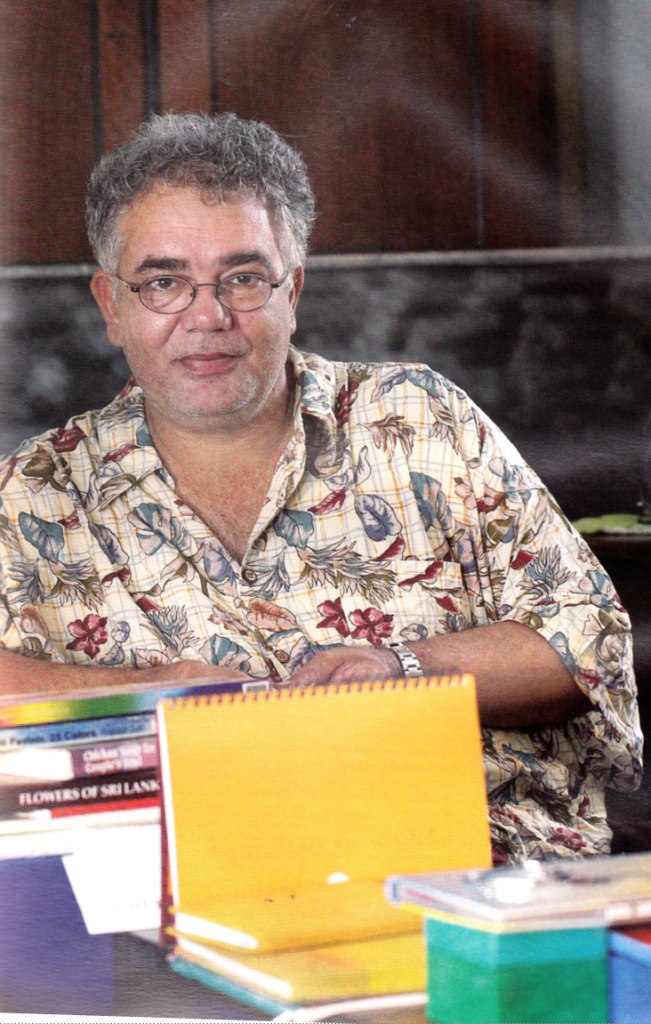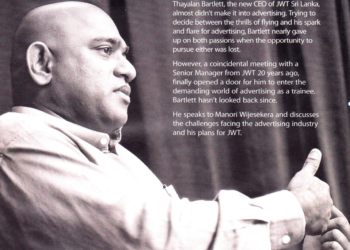A new book of photographs – “Sri Lanka Colour” – collects images by world-famous photographer, Dominic Sansoni, in a tribute to the exuberance of Sri Lanka: her people, scenery and effusive colour. “Business Today” meets Sansoni, Sri Lanka’s leading professional photographer, for breakfast on the eve of his 50th birthday.

Cheese produced by a retired planter, marmalade made by nuns in Nuwara Eliya, eggs lightly scrambled and eaten with pol sambal, aromatic coffee – breakfast chez Sansoni reflects the best. The Sansoni home in Anderson Road could be in the heart of the countryside with its rural ambience, not in busy Colombo. Rooms run into each other and into secret gardens, living space is packed with curios, the place has an unaffected style. Like the man himself, it is unpretentious, at ease, and reassuring. Dominic Sansoni and his wife Nazreen are hosting breakfast for a writer, a photographer and Aunt Mary. The discussion turns to why Sansoni took up photography. “I never knew why,” he says. “Yes, you do,” says Aunt Mary. “It was at school when you had to choose a fine arts subject so you chose photography.”
Her remark sets Sansoni reminiscing. “I took it up to get out of life-drawing classes.” What followed was a three year course in photography at one of England’s foremost art colleges that used to be known as the Guildford School of Art, but was called Farnham by the time Sansoni attended it. He returned to Sri Lanka in 1979 and became apparently permanently attached to a camera. He carried one with him everywhere and used it to photograph anything that fascinated him – which was objects that most people would glance at and then pass by without further thought.
A portfolio of his photographs was published in 1981 in the very first issue of Serendib, the in-flight magazine of the then Air Lanka. Sansoni confesses modestly to being “happy that someone used my work.” His fame as a photographer began then, and he was soon in demand, being commissioned by major magazines like Asia Week and Newsweek to photograph in Sri Lanka and abroad. He embraced news photography to complement his more imaginative feature photography work, while also accepting commercial assignments like factory and hotel photography. His reputation spread and even at 50 he seems amazed that photographic assignments have enabled him to visit so many countries. His extensive portfolio now includes photographs of India, Maldives, Thailand, Vietnam, Cambodia, Nepal, Singapore, Malaysia and Brunei.
Throughout the 1980s and 1990s, the byline “Dominic Sansoni” was to be seen alongside memorable images, both beautiful and horrific, published in the world’s press. His name seeped into consciousness, becoming almost synonymous internationally with Sri Lanka. To the question of whether he has mell.owed now he has reached 50, there is a discussion as to what mellow means. Finally he admits that he no longer grabs the camera to rush to a disaster for a news shot. He is more likely to be photographing an artist at work, or a display of frangipani flowers floating in an urn. “He’s always relaxed,” says his wife, adding quickly: “The intensity is still there.” “I never think about it much,” says Sansoni. “Although perhaps now I photograph more for myself.” Talk on technical innovations leads to a comment from Sansoni that a digital camera is just another camera. He admits that time is saved shooting digitally and having a darkroom on a desk, but one gets the impression that he prefers to be a creative photographer eschewing short cuts. The secret to his technique seems to be his personality; people warm to him as he chats and shoots, resulting in the essence of an individual being captured by his camera. One wonders how much his apparent ingenuous nature is part of a dedicated, professional approach to his work.
He knows exactly what he is doing but hopes to disguise that by seeming at times indecisive. He brings out the best in people and is renowned for encouraging others, even fellow photographers who could become rivals. He has made the most of his involvement with the Barefoot store in Galle Road to display art of all kinds and promote talented artists. He seems able to preserve artistic sensitivity while maintaining a shrewd business acumen. The nature of the man shines through his work: it is deep, it is serious, but a sense of fun bubbles through. His recently published book – “Sri Lanka Colour” – captures the many sides of Sansoni as well as of Sri Lanka. It is a magnificent volume that is bound to become a collector’s item, especially as it has been produced in a limited edition and there is unlikely to be a reprint. That’s because it is printed on imported paper with a cover of scarlet fabric imported from Italy. With rising costs, it would be difficult to repeat.
The nature of the man shines through his work: it is deep, it is serious, but a sense of fun bubbles through.
Sansoni is profuse in his praise for Nelum Harasgama Nadaraja who designed the book and for Shehan de Silva who nursed the project to reality in its printing by Gunaratne Offset Ltd. It is a beautiful book that does justice to the stunning images in it. These include several pictures of doors, shutters and screens since Sansoni likes to record images created by others, as well as by nature. In doing so, Dominic Sansoni has added to Sri Lanka’s heritage since much of what he has photographed over the past 25 years no longer exists, or is swiftly disappearing. A photograph of a tray of bread newly emerged from an oven in Bentota, with each loaf nestled companionably with its neighbour, evokes reality: the warm smell of the bakery and the delicious taste of the bread. Sansoni is drawn to colour, especially strange combinations produced by man, like the shelf of bottles containing coloured powder at a medical shop in Jaffna, or a display of pink cordials at the Trincomalee bus stand. There are landscapes too, many in minute detail such as a palm leaf of gold in Colombo and an unusual angle of a canopy of palm leaves in Kandy. If a door is blue, Sansoni is sure to photograph it and he includes a photograph (a deliberate joke at his own expense?) of a bright red panel with the word BLUE highlighted on it – in green. The adjoining page has almost the same rich red background, but is of a painting of a Kandyan conch shell blower looking self-conscious. The detail of a youth painted on a door at a Kandy shrine could have been a portrait by Sri Lanka’s iconic artist, David Paynter. Alas, Sansoni reports, the seductive, apprehensive figure has now been retouched into insignificance. There are 143 photographs in this volume, the first of planned series of Sansoni’s work, and it is a book to treasure for its presentation as well as content. It is a handy, almost square (24×21.5cm) tome that was five years in gestation. It is a record of a colourful lifestyle that is fading now. While it is worth buying for the sheer enjoyment of looking at the images and possessing one’s own copy, it could be a worthwhile investment too because of the rarity value it will gain over the years. Sansoni said he buys five copies of special books so that each of his five children can have their own. That’s what any parent should do with this book too, so that children have a better idea of how to see and appreciate the colours and heritage of Sri Lanka. (RE)
“Sri Lanka Colour” by Dominic Sansoni,
Rs4,800, available from Barefoot, 704 Galle Road, Colombo 3. tel: 258 9305.






